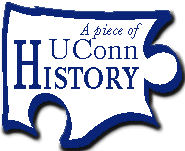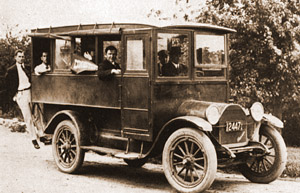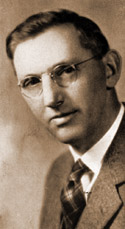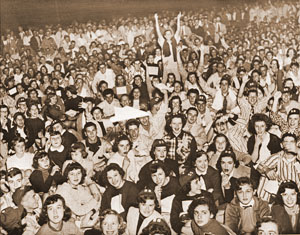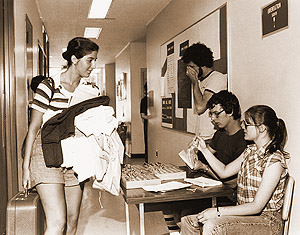|
This is an archived article.
For the latest news, go to the
Advance Homepage For more archives, go to the Advance Archive/Search Page. | |||||||||||||
|
Welcome for Freshmen Sets the Tone
For What's To Come
They had been through the orientation program during the summer and, after moving into their residence halls, they attended the annual Convocation with their parents. Convocation is the beginning of the Husky Weeks of Welcome (WOW), designed to ease the transition to the new phase in their lives, as college students. They'll get a boost in adjusting to the rigors of academic pursuits, in managing study versus recreational time, and in making their way through the next four years or so. That help will come through the First Year Experience, started three years ago. And new this year is the Northwest Experience, a program in the newly renovated Northwest Campus residence halls, where nearly 900 freshmen will live and study together. Yet this is not the first time efforts have been made to welcome freshmen. Rather than driving up with mom and dad in the family car, students arriving between 1881 and into the 1930s came to the campus in Storrs by the Central Vermont Railroad. They got off at the Eagleville Station and either walked or rode to the campus in a horse-drawn buggy, or later a "jitney" - equivalent to a mini-bus today. Route 195, acquired as a state road in 1916, wasn't paved until 1931.
Whatever welcome there may have been in those early years was limited. The course catalog advised that "upon arrival, new students should report at once to the Secretary's office in the Main Building." That was Old Main, the administration building from 1890 to 1929, located on what is now the field between Beach and the former Waring Chemistry Building. Other than course registration, records do not indicate how these freshmen were officially welcomed into their new surroundings. They were, however, "welcomed" by upperclassmen, primarily through hazing and traditions such as the annual freshmen-sophomore banquet and rope pulls.(Please see earlier articles in the series on Fall Traditions.) In the 1920s, the first major campus event of the academic year was the President's Reception, hosted by President Charles L. Beach. Incoming classes at the time numbered around 100 students. The first handbook published for students, printed for the 1921-22 academic year, advises that it is "essential that incoming students read the constitutions of our governing organizations." In the fall of 1921, new students registered for classes on Sept. 20 and classes began the next day, so any orientation was brief. In 1930, a new course showed up in the Course Catalog for Connecticut Agricultural College: Orientation for Women, or Home Economics 27, was a one-semester, two-credit course taught by Mildred French, who was later dean of home economics, dean of women, and director of housing for women. The catalog description says the course "considers the methods and objectives of study; the organization of a land grant college; and the various professional and vocational occupations entered by college women." Beginning in 1932, the course became Education 100, still titled Orientation for Women, but it carried only one credit. Also that year, a similar course was offered for men: Education 101, Freshmen Problems.
The two carried the same course description: "This course considers the methods and objectives of study, organization of the student's time, participation in extra-curricular activities, and other problems related to student life." But there was one additional sentence in the description of the men's course: "An opportunity will be given to meet representatives of various occupations." The men's course was taught primarily by Sumner A. Dole, the first dean of men, coach of men's baseball, football and basketball in the 1920s and 1930s, and a professor of physical education. Over the next decade, French and Dole would continue to teach the orientation courses required for all freshmen. Dole had help, because men significantly outnumbered women at the time: there were 512 men and 194 women enrolled in 1932-33. Changes to the course came in the years following the College's transition in 1939 into the University of Connecticut. The 1942 catalog lists one course for both men and women, Interdepartmental 100, titled Orientation. It was offered in the first semester only, and carried one "non-academic" credit. It was now required of all students entering the University with less than two semesters of previous college work. Included in the list of those teaching the course were members of the student personnel division, one of the new divisions created by the reorganization that came with becoming a university. "This course," says the description in the catalog, "is a continuation of the orientation program begun during freshmen week and is designed to acquaint the student with the important aspects of university life. One of its purposes is to help students to become oriented with respect to their educational and vocational objectives. An attempt will be made to help each individual student understand the various problems he will be confronted with in the University and to help him develop his initiative in discovering ways and means for meeting these problems, the ultimate aim being to aid students in assuming the responsibility for their own self-determination." Personal pronouns aside, the course was for men and women.
With the 1944-45 academic year, the student personnel division, which included orientation and counseling services, provided "a program for the orientation of new students and for counseling all students during their residence at the University." Included in the orientation program was Freshmen Week, which since the early 1930s was a three- to four-day period in which freshmen registered for courses, attended a reception hosted by the president, and were acquainted with their new home. The handbook for the orientation class from 1944 is a 164-page paperback volume that includes a history of the University, and discourses by faculty on literature, the arts, and other academic pursuits to which the new students might be attracted. Recommendations and tips on adjusting to campus life, how to study, and extra-curricular activities in which to participate, are also included. The orientation class was offered for the last time in the fall of 1960. On Oct. 10, acting on a series of recommendations for new minimum general education requirements, the University Senate voted to eliminate the course. Through the 1960s and into the 1970s, the orientation program was part of the activities of Freshmen Week, which included meetings with residence hall advisors, course registration, an address by President Homer D. Babbidge, a barbeque, and other events. Since publication of that first student handbook in 1921, new students have received volumes of material to acquaint them with their new academic life. But one piece of advice from 1921 is still among the best: "Study hard, play hard, work hard," says the handbook. "Four years may seem long to you now, but they go mighty fast. You can't afford to let your chances slip through lack of effort. 'Live life to the hilt.'" Welcome to UConn. Mark J. Roy Sources: various issues of the Nutmeg Yearbook, course catalogs, and student handbooks. These and other materials in the University Archives are available at the Thomas J. Dodd Research Center. | |||||||||||||
 hen freshmen started
classes for the first time last Wednesday, August 30,
they already had a pretty good idea of what to expect in their
new lives as students at a public research university.
hen freshmen started
classes for the first time last Wednesday, August 30,
they already had a pretty good idea of what to expect in their
new lives as students at a public research university. 